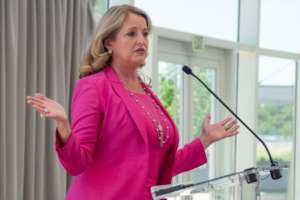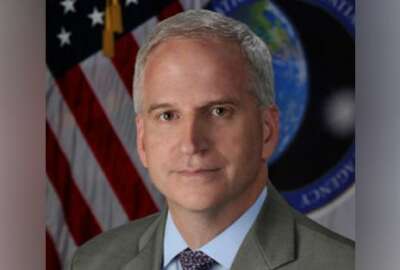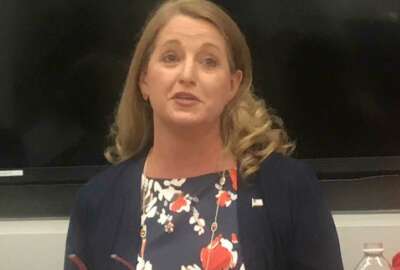 Exclusive
Exclusive Federal CIO Kent: Federal Data Strategy is a muscle building exercise
Suzette Kent, the federal chief information officer, said agencies have been lining up internal resources all summer to begin tackling the goals of the Federal ...
The final implementation plan for the Federal Data Strategy is less than a month from release.
Agencies have been lining up internal resources to begin tackling the goals of the plan all summer, naming a new set of chiefs—data, statistical and evaluation officers.
Suzette Kent, the federal chief information officer, said the Federal Data Strategy, and its corresponding implementation plan, will drive improvements to how agencies deliver on mission and services as well as supporting economic research and development and national security. The Office of Management and Budget released the data strategy in June outlining 40 goals to give agencies a solid working foundation around governance, infrastructure and staffing to make data more valuable.

Kent said the administration is focusing on three data sets initially: geospatial, financial management and artificial intelligence research and development.
“If you look at where we had success and gathering data, making it available, making it available in a public way that’s that promotes jobs that promote our economy, and the mission of many, many agencies in geospatial has been a phenomenal success story. So that’s going to continue that is a focus and it’s an increased focus,” Kent said after her speech at the 2019 ImagineNation ELC conference sponsored by ACT-IAC. “Financial management is the second and that is to prioritize with agencies as we seek to improve our data inventory, tools, quality of the data, how we tag and label data and how we use and share data. Financial management helps us address issues with waste, fraud and abuse, visibility of how programs are executed and many other things, we can see that through the financial data. And then the third area of data is data that has been deemed high priority externally to support AI research and development.”
Agencies have seen the value in geospatial and financial management data sets, but Kent said there are more and broader uses because of better technology and more understanding of the information.
“We will be able to update the ways that we make it available, whether that’s secure enclaves, whether that’s application programming interfaces (APIs), whether it’s common standards around what the data looks like, as well as an ethics framework for how we make it available for what purposes, how we interact with citizens, and how we use the data, financial management data, and geospatial data, have less personal information,” Kent said on Ask the CIO. “So it lets us build the muscles and the maturity in some of those practices. We are concurrently addressing some of the things you will see in the data strategy, like ethics frameworks, the ability to identify data, other types of security tools around monitoring the use of the data, and how we interact with customers. It’s our responsibility to tell them what we intend to do with it. So those things were much more complex with other types of data. So by starting with this set of data, we’re building the muscles, the strength, the infrastructure, as we prepare for moving into some of the same practices with more sensitive data.”
Commerce’s data listening tour
Karen Kelley, the deputy secretary of the Commerce Department, said at the ImagineNation ELC conference that the strategy and implementation plan will make agencies are managing and using data in a consistent way. She said that will make sharing across agencies easier and more valuable.
Ed Kearns, Commerce’s chief data officer, said he’s been conducting a listening tour with the bureaus to better understand their business and technical needs.
“Some already are bubbling to surface like training for data scientists,” Kearns said at the conference. “The governance board is meeting for second time this month to talk about what do we have and what do we need around tools or data or structure.”
Kearns said the listening tour is part of how Commerce is trying to overcome one of the biggest obstacles to sharing data.
He said the program data is hard to obtain, and there is a “gap of understanding between citizens and people doing service delivery. We hope what comes from these efforts is the breakdown of the lack of understanding of what civil servants are doing to deliver these products to citizens.”
CDO reporting structure
Commerce is not alone in their challenge. That’s why Kent said it’s critical for CDOs and their partners to help make change and build the muscle, particularly around geospatial and financial management data.
“We’re starting with data sets because there’s not a lot of bias and wind speed or wave height. But humans have bias and how we understand that, and we apply frameworks to the way that we look at data to ensure that the wrong types of perspectives aren’t represented is or disciplines that we’re building,” she said. “When we talk about improving our workforce skills around data science, and we’re doing some rescaling things with data right now. We just aligned CDOs in all agencies. We are asking agencies to put more training dollars into improving and lifting our overall data literacy, that’s how we move down that path. So training data sets, clarity of the question that we’re trying to solve the number of the volume and the amount of data that are used in developing these types of things become critical.”
Kent added OMB was intentional in how it developed the guidance to implement the Foundation for Evidence-Based Policymaking Act so as not to prescript the CDO’s reporting structure.
She said since every agency was starting from different places and had different requirements, the focus was on the activities and responsibilities of the CDO and others.
“I expect as we go over the next four years and we see other things that come out of use and we walk up this path of improved maturity, we may see some shift. But the conversations we’ve had have been about getting started and where is the initial work effort,” Kent said. “Many of the alignments reflect where they think is more new work rather than things they think they’ve already done. What they want to accomplish is different and the types of investments they need to make, at least in the short term, based on the data strategy and the first two steps of foundation are different.”
Copyright © 2024 Federal News Network. All rights reserved. This website is not intended for users located within the European Economic Area.
Jason Miller is executive editor of Federal News Network and directs news coverage on the people, policy and programs of the federal government.
Follow @jmillerWFED







